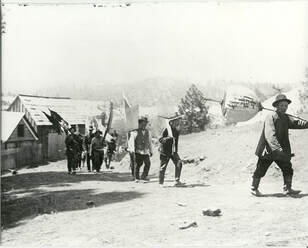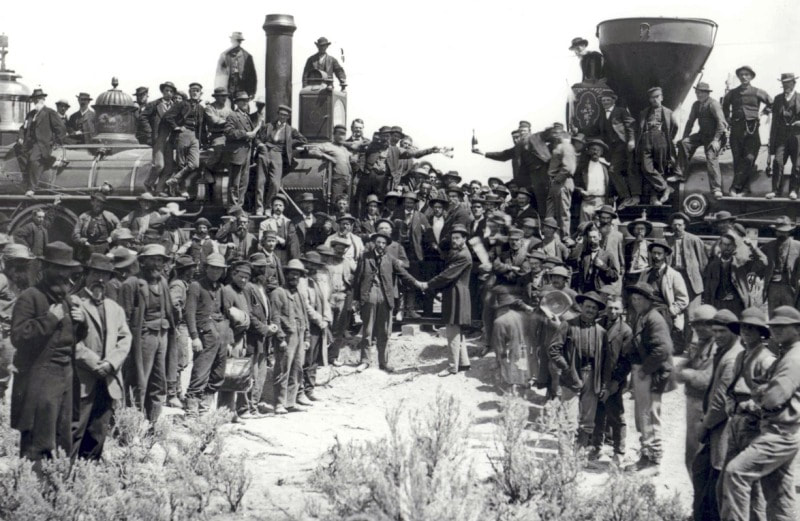 A procession of Chinese workers near Dutch Flat, California (Photo courtesy of Placer County Museum) A procession of Chinese workers near Dutch Flat, California (Photo courtesy of Placer County Museum) Over 20,000 Chinese migrants underwent back-breaking labor for over 6 years from 1863 to 1869, building a railroad that would connect the existing U.S. rail in Iowa, to the Pacific Coast. This project started out with a group of just 21 Chinese migrant workers, as they were originally deemed "too weak" to do the job. Soon after construction started, however, the demand for labor increased, and white workers didn't want to do such hard, manual labor. And so, more Chinese immigrants were hired, as they were desperate for jobs as they came to the U.S. By 1865, over 90% of workers were Chinese migrants. They became a crucial part in the construction of the railroad, and yet, are forgotten by history books today. By the peak of construction, over 12,000 Chinese workers were hired to work on the railroad, getting paid an average of just 26$ a month for 6 day weeks. While their salary did eventually increase to 31$-35$ per month, it fell short of the salary the whites were receiving--around 40$. Furthermore, they were forced to toil under more dangerous conditions, causing from 50-1,200 Chinese migrant deaths (although no records were kept by Central Pacific so the exact number is unclear). Finally on June 25, 1867, they had enough. Over 5,000 Chinese workers put down their tools, went to their camp, and sat. Everyone was amazed at the sheer number of strikers, but didn't want to give in to the Chinese. So Charles Crocker, superintendent of the Central Pacific railroad, came up with an idea. He would cut off all food supplies and starve them until the strike let up. And it worked. With no change, the strike was written out of history. And as the number of Chinese immigrants in the west increased, so too, did the levels of anti-Chinese sentiment. In fact, just a few years later, the infamous Chinese Exclusion Act was passed, preventing Chinese laborers from immigrating to the U.S. at all. When the railroad was finished, this famous photograph depicting the connection of East and West has a noticeable lack of Chinese workers. Not only this, news reports also failed to acknowledge the Chinese workers who played such a crucial role in the construction of the railroad. 151 years after the construction of the first transcontinental railroad was completed, it's still important as ever to remember the Chinese migrant workers who suffered back-breaking labor to advance the United States forward.
As May brings the peak of Covid-19, it's important to fight against the influx of xenophobic hate crimes on the Asian-American community. Little of the U.S. population know the toils of the Chinese migrants during the construction of the railroad, nor the importance of Asian immigrants during wartimes. That'a what we aim to correct. Author: Carina Sun
0 Comments
Leave a Reply. |
In Honor of Asian Pacific American Heritage MonthWe are bringing you the stories of inspirational Asian Americans from history. Read More:5/30/20 - The Exceptional Example Ronald Takaki Set
5/27/20 - The Incredible Legacy of Kalpana Chawla 5/26/20 - When Marrying a Non-American Meant Losing Your Citizenship 5/25/20 - Honoring the 442nd Infantry Regiment 5/24/20- A Glimpse at Asian-Americans in Hollywood -- Miyoshi Umeki 5/22/20 - The Oriental Schools of San Fransisco 5/21/20 - Equality For All Colors - Yick Wo v. Hopkins 5/20/20 - An End To Police Brutality: Peter Yew's Stand 5/19/20 - Finding His Form: Linsanity in 2012 5/18/20 - Internment and Injustice: Fred T. Korematsu 5/17/20 - The Courageous Stand of Gene Viernes and Silme Domingo 5/16/20 - The Unbreakable Spirit of Wong Kim Ark 5/15/20- The Admirable Perseverance of Patsy Takemoto Mink 5/13/20 - The Lasting Legacy of Grace Lee Boggs 5/12/20-Remembering "The Forgotten" -- The Chinese migrants who built America's first Transcontinental railroad 5/11/20 - The Singing Neurosurgeon: Dr. Ayub Ommaya |


 RSS Feed
RSS Feed